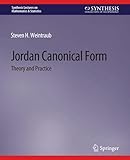Jordan Canonical Form [electronic resource] : Theory and Practice / by Steven H. Weintraub.
By: Weintraub, Steven H [author.] .
.
Contributor(s): SpringerLink (Online service) .
.
Material type:  BookSeries: Synthesis Lectures on Mathematics & Statistics: Publisher: Cham : Springer International Publishing : Imprint: Springer, 2009Edition: 1st ed. 2009.Description: XI, 96 p. online resource.Content type: text Media type: computer Carrier type: online resourceISBN: 9783031023989.Subject(s): Mathematics
BookSeries: Synthesis Lectures on Mathematics & Statistics: Publisher: Cham : Springer International Publishing : Imprint: Springer, 2009Edition: 1st ed. 2009.Description: XI, 96 p. online resource.Content type: text Media type: computer Carrier type: online resourceISBN: 9783031023989.Subject(s): MathematicsJordan Canonical Form -- Solving Systems of Linear Differential Equations -- Background Results: Bases, Coordinates, and Matrices -- Properties of the Complex Exponential.
Jordan Canonical Form (JCF) is one of the most important, and useful, concepts in linear algebra. The JCF of a linear transformation, or of a matrix, encodes all of the structural information about that linear transformation, or matrix. This book is a careful development of JCF. After beginning with background material, we introduce Jordan Canonical Form and related notions: eigenvalues, (generalized) eigenvectors, and the characteristic and minimum polynomials. We decide the question of diagonalizability, and prove the Cayley-Hamilton theorem. Then we present a careful and complete proof of the fundamental theorem: Let V be a finite-dimensional vector space over the field of complex numbers C, and let T : V → V be a linear transformation. Then T has a Jordan Canonical Form. This theorem has an equivalent statement in terms of matrices: Let A be a square matrix with complex entries. Then A is similar to a matrix J in Jordan Canonical Form, i.e., there is an invertible matrix P and a matrix J in Jordan Canonical Form with A = PJP-1. We further present an algorithm to find P and J, assuming that one can factor the characteristic polynomial of A. In developing this algorithm we introduce the eigenstructure picture (ESP) of a matrix, a pictorial representation that makes JCF clear. The ESP of A determines J, and a refinement, the labeled eigenstructure picture (ℓESP) of A, determines P as well. We illustrate this algorithm with copious examples, and provide numerous exercises for the reader. Table of Contents: Fundamentals on Vector Spaces and Linear Transformations / The Structure of a Linear Transformation / An Algorithm for Jordan Canonical Form and Jordan Basis.


There are no comments for this item.